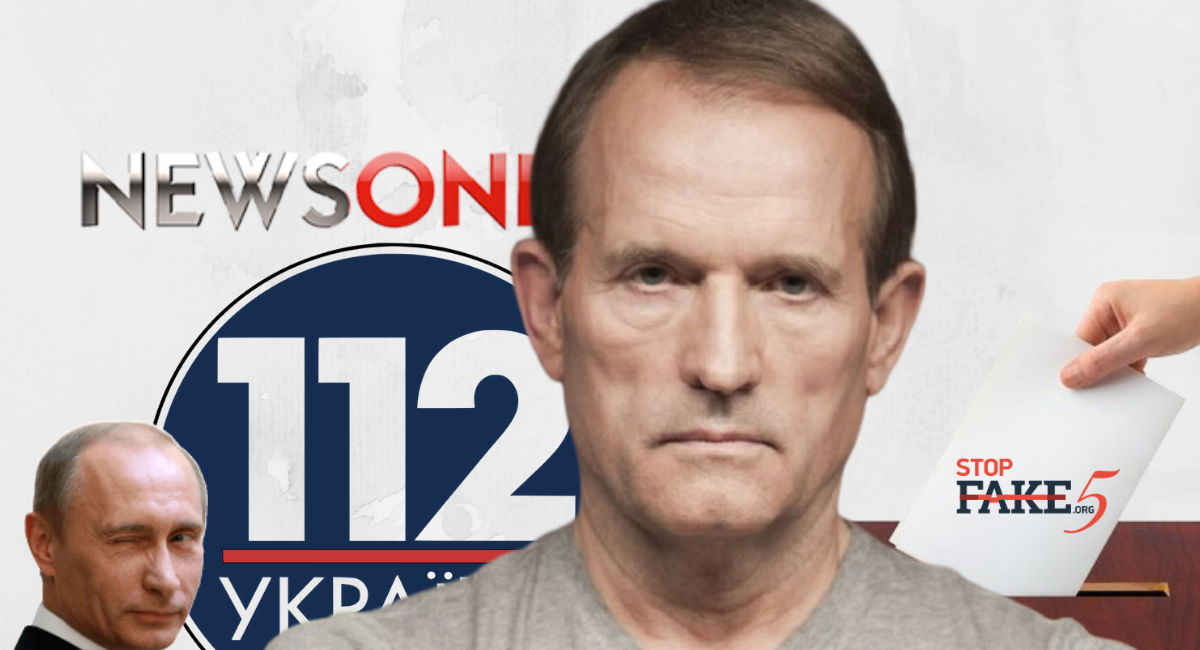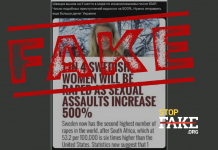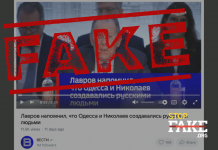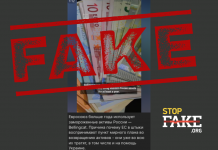Author: Anastasiia Grynko, PhD
Fieldwork and Coding: Artem Laptiiev
For ‘Stop Fake’
January-February 2019
Introduction
Ukraine has been placed in the center of hybrid war since Russian occupation of Crimea and the war in Donbas[1]. Forgeries, or fake news, manufactured by Kremlin for political and military purposes, have been dissiminated inside and outside of Russia targeting various states and audiences. Fake news have been widely defined as manipulative information in media on high-profile events that ”does not correspond to reality[2]”.
To counteract the growing flow of propaganda and debunk the fakes about events in Ukraine, in March 2014 Ukrainian journalists and media activists have launched the Stopfake.org Project. The Stop Fake fact-checkers investigate the stories of media outlets and feature the ones that have been proved as falsificated[3]. Later this initative grew into an information hub specialized in examination and analysis of all aspects of Kremlin propaganda[4].
Fake Narratives in Previous Research
The Stop Fake team has accumulated and archaived the database of fakes that have appeared in media throughout the five years of the war in Ukraine. One of the recent research based on this data, traced the evolution of Russian propaganda and exemined the core narratives that have been systematically destributed by Kremlin as a part of its military strategy and foreign policy measures[5]. Looking at the roots and strategies of Russian propaganda that have been widely applied in Soviet Union, Fedchenko (2016) concludes that current propaganda messages in many ways do echo the earlier Soviet propaganda patterns and, therefore, disinformation actions taken by Russia should not be narrowed to current moment and limited to the onglong war in Ukraine:
“Although Russian war in Ukraine became the climax point for the use of Russian propaganda, it is a continuation of Soviet propaganda that never disappeared with collapse of Soviet Union…In reality it was just reviewed, rebuilt and transformed according to contemporary situation in order to increase its efficiency” (ibid, p.146).
This researh has also identified the 18 key narratives related to Ukraine that have been embedded into the fake news stories. Specifically, the identified fake messages promoted the narratives about Ukraine as a “Western-backed junta”(1), “fascist state’ (2), “failed state” (3). They have also tended to depict Russia as “not a part of the occupation/war” (4). The part of the fake stories have been built around the themes of Ukrainians Army (5), Volunteer battalions (6), Internally displaced people and refugees to Russia (7). Besides “Territorial claims’ from neighboring countries (8) and the theme of “Territorial disintegration of Ukraine” (9), Fake stories involved “legitimization of Crimea annexation and occupation of Donbass by foreign governments, international organizations or foreign media” (10). According to Fedchenko (2016), fake narratives also included the statements that “War in Ukraine is actually conducted by the US, NATO or private contractors” (11), promoted “Decline of Western support for Ukraine” (12), “Maipulated news on International organizations (13), disinfromed on “Disintegration of the EU” (14), “Decay of the US and West in general” (15). Other forgeries have also involved the fake stories on the “MH17” (16), “AIDS/ZIKA/ other disease” (17) and “Ukraine/Turkey/Syria/ISIS developments” (18).
Media, Fakes and Elections
Political events, and especially elections, are generally asociated with times when media and information practices turn to be at a high risk of manipulations. For example, the study conducted at the George Washington University in 2018, found that fake news, particularly the ones, dissiminated online (in particular, via Twitter accounts), have been one of the remarkable outcomes of the 2016 presidential election cycle in the US[6]. According to this study, many accounts did tweet in lockstep with the Kremlin’s message, including hundreds of accounts with more followers than top Russia`s Internet Research Agency[7] trolls. Hindman M. & Barash V. (2018) conclude that most fake news on Twitter involved into spreading messages during the US elections were linked to a few established conspiracy and propaganda sites, and coordinated campaigns generally play a crucial role in spreading fake news.
In Ukraine the next Presidential elections are scheduled for the 31 March 2019. According to the Ukraine’s Central Election Commission , the voters will select one of the 44 candidates for the elections[8]. Since the beginning of the Presidential campaign, Ukrainian watchdog NGOs and the National Council of Information have been concerned with the regularly occuring violations. Specifically, they repored on the cases when Ukrainian media (and, particularly, the oppositoinal ones) violated elections legislation and media professional standards, placing one-sided positive coverage of the oppositional candidates and neglecting the arguments from the part of another candidate.
The recent critisism of the oppositional, in particular the 112 and NewsOne Channels, involved accusations in utilization of hate speech[9] , dissimination of fakes[10] and “setting agenda that is too close to Russian propaganda”[11]. Importantly, a significant part of the criticism has been directed to the political talk shows of the oppositional TV channels. For example. the NGO observers have claimed a hardly neutral behaviour of the talk show anchors/hosts. To illustrate it, the NGO Detector Media reported on the situations when the pro-oppositional guest of the talk show could recieve a favourable place (closer to the anchors) and has been given the floor much more often than other participants: “the show hosts ancors… addressed him [representative of oppositional block] more often asking to put the last word, summarize and conclude each part of the discussion” (ibid.).
Despite of the number of reforms and significant improvements of situation with journalism freedom in post-EuroMaidan (since 2014) Ukraine and a relatively diverse media landscape, Ukrainian media are still reported as manipulated by the political and business interests and are scored as partly free by the Freedom House[12]. Besides the internal challenges (corruption, not effectective mechanisms of law implementations and others), situation with media freedom has become even more complicated as a result of the external aggression and culmination of information war[13].
How does information war reframe the work of Ukrainian media (especially, the oppositional ones) in times of Presidential campaign? What messages and themes (specifically, the fake ones) have been embedded into narratives promoted by Ukrainian media during presidential campaign? With the help of which themes, arguments and voices have they been embedded?
The idea of this research has been inspired by the interest to get answers on those questions. It has been also motivated by the increased risk of manupulations in media during the Presidential campaign.
Research Methodology and Sample
The research has been focused on the two oppositional TV Channels that, based on the mentioned already reports by media watchdog NGOs, tend to violate media standards and follow the line of Kremlin propaganda. The goal of this researh has been to investigate the quality of the content by two oppositional Ukrainian TV channels during the Presidential Elections campaign 2018-2019, and, specifically, trace the fake narratives related to Ukraine.
The research has posed the following research questions:
RQ1: What fake narratives have been set and promoted by the oppositional TV Channels in Ukraine?
RQ2:With what themes and arguments have the fake narrative patterns been
related?
RQ3: Who (what sources/actors) have been involved into placing and supporting fake narratives?
The research applied the method of qualitative (thematic) content analysis, as it allows detailed understanding of themes and intentions behind the text. The sample included the main political talk shows of two oppositional channels the 112 and the NewsOne: ‘Ukrainian Format’ (Украинский Формат, Newsone Channel) and `Pulse’ (Пульс, 112 Channel) broadcasted weekly in December 2018.
TheNewsOne is claimed to be both news channel and multimedia platform intending to be connected with the viewers 24/7 and keeping them informed about news in Ukraine and all over the world[14]. “Ukrainian Format” (Украинский формат”) is the NewsOne`s main political talk schow broadcasted every Wednesday. The 112 is positioned as the informational and educational channel and agency[15] with its main political program talk show Puls (Пульс) “hosting politicians, experts and viewers discussing the most needle-sharp questions of the country”[16].
Totally 8 programs broadcasted in December 2018 have been analysed. The sample included the Ukrainian Format the programs: the 7th, 14th, 21s and 28th December; Pulse: the programs of the 4th, 11th, 18th and 25th December. This research has been manly based on analysis of the text of the programs. During the fieldwork, the December programs have been retrieved from the TV Channels` online archives, fully viewed and thematically coded according to the previously elaborated themes and units. The themes and units for analysis have been developed as a result of the pilot research, conducted at the beginning to preliminary develop and adjust the themes for the further analysis.
Key Findings
“Ruined”, “Sinking into poverty” and “Dependent on Russia” Ukraine: Top-3 Fake Narratives
Based on the content analysis, both TV channels demonstrated the same three most frequently placed narratives (figure 1) in December. Interestingly, they have been mainly built around the description of situation in Ukraine and intended to depict Ukraine as a poor state that has been led to total ruin. Ukrainian Government has been mainly mentioned as the reason of the total poverty; meanwhile Russian invasion and war have not been included into this narrative. Additionally, Ukraine has been narratively framed as the dependent on Russia by both TV channels.
- “Ukraine has been led to total collapse. All reforms failed”. Based on the content analysis, this narrative was the most frequently repeated (at least 27 times) during the political talk shows by the both TV channels. It mainly referred to the total failure of the current President and the Government of Ukraine, and specifically, the failed reforms leading the country to collapse. The 112 Channel placed the messages constructing this narrative 21 times and the 112 Channels claimed it 6 times. The data has also indicated the sources (actors), who were the most active in placing this narrative at the talk show discussions. They were mainly the oppositional parties politicians; specifically, on the 112th channel it was 7 times repeated during the different programs by Nestor Shufrych and 4 times by Natalia Korolevska. Among other sources who contributed into voicing of this narrative were Olexandr Moroz and Mykhailo Dobkin.
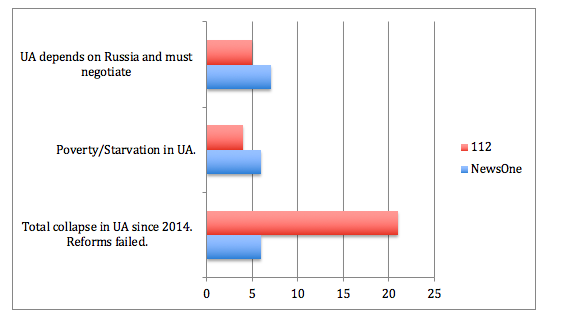
- “Total Poverty”, “Ukrainians are about to eat dogs”. This narrative was placed at least 10 times by both TV channels in December. It often went along with the various, appealing to emotions, fake and exaggerated details. For instance, one invited expert introduced as the political scientist stated that “many Ukrainians commit suicides as a result of poverty and starvation”, “people are hardly eating dogs” (invited MP from the Party `Nash Kray`), “Ukrainians are as poor as people in Zimbabwe”, “People can not afford buying bread and salt”, “Ukrainians are escaping from the country because of poverty”, “Zero investments are coming to Ukraine”. The mentioned messages have been usually linked to the current authorities` actions”: “during the last three years they took everything and left them [people] completely poor”.
- “Ukraine depends a lot on Russia”. “There is no way for Ukraine without Russia”, ”Ukraine must negotiate with Russia”. December talk show participants have contributed into promotion of this narrative totally 12 times on the 112 and the NewsOne. In December the 112 Channel devoted one whole show to the theme of suspending the operation the treaty on friendship between Ukraine and Russia (the program from 14 December 2019). This program contributed significantly into spinning this message. However, this narrative has been quite popular and sounded during the other programs on both channels included into the research sample. To support this narrative, the invited speakers produced various arguments, for example: “Ukrainian industry dies without Russia”, “nobody else will purchase Ukrainian products”, “if there will be no Russians in Ukraine, Ukrainians will have no work”, “Ukraine and Russia are friends, they can not be separated. They share a big boarder”, “many Ukrainians support Russia”.
“Russia did not attack Ukraine”, “Crimea has not been occupied” and “West is tired of Ukraine” (Other Fake Narratives)
Other fake narratives that have been shared by both TV channels have tended to legitimize annexation of Crimea and promote the message that Russian did not invade Ukraine. The oppositional TV channels have also placed narratives that manipulated international organizations and Western countries showing them as ones who have no political, economic or any other interest in Ukraine. With different messages and proclaimed by different speakers, the following fake narratives have been indicted on both NewsOne and 112 Channels (Figure 2):
- “Russia did not occupy Ukraine” (“Poroshenko started the war on Donbas and this led Ukraine to poverty”)
- “Crimea: legitimation of annexation”
- “Manipulations with international organizations”
- “West is no more interested in Ukraine”, (“West is tired of Ukraine”).
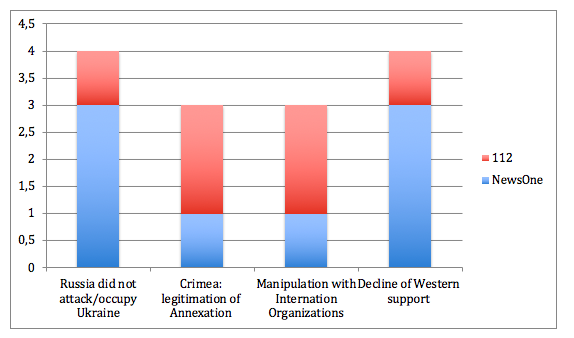
The research has also indicated other fake narratives that appeared at least once on one of the oppositional channels:
- “Ukraine is a fascist state” (NewsOne)
- “Ukraine does not care about internally displaced people from Donbas” (NewsOne)
- “Partition of Ukraine`s territory” (NewsOne)
- “Ukraine is a puppet of the West/US” (NewsOne) – “Ukraine is working for American economy”, “US have appointed the head of Ukrainian Post, and Ukrainian Government is aware of it”, “One of the western states ordered to ruin Ukrainian industry”.
- “Sanctions against Russia do not work”. (“They are not effective and harm EU, not Russia” (NewsOne).
- “Manipulations related to relations between Ukraine and EU” (112): “EU did not want to work with Ukraine after 2014 and took away all investments”;
- Decay of West: “Old and weak Europe intends to take the territory of Ukraine” (112).
- “Tomos”: “The single Ukrainian church has been created as a result of aggressive actions and pressure from the side of Ukrainian government” (112).
Politics, Economics, and Sometimes Society: The Themes, Within Which Fake Narratives Have Been Embedded
The talk shows included into the research sample, have been mostly focused on hard topics. So the majority of fake narratives have been associated with the economical and political themes, and less often, with social themes (Figure 3). Other themes, like, for instance, War in Ukraine, Ukrainian Army, Volunteer Battalions, Internally Displaced people, Religion, received less attention during the December programs on both channels.
The content analysis has indicted specific topics that went across the both channels in December 2018 and provided space for placing fake narratives. Specifically, both channels devoted much attention to the Suspension of the Treaty on Friendship, Cooperation, and Partnership between Ukraine and the Russian Federation (1), Moratorium on sale of Ukrainian land (2) and the questions of How to get Donbas and Crimea returned to Ukraine (3). NewsOne has also granted time to the topic of Social benefits, meanwhile the 112 devoted a significant part of discussion on Emigration from Ukraine and restrictions against Russians coming to Ukraine.
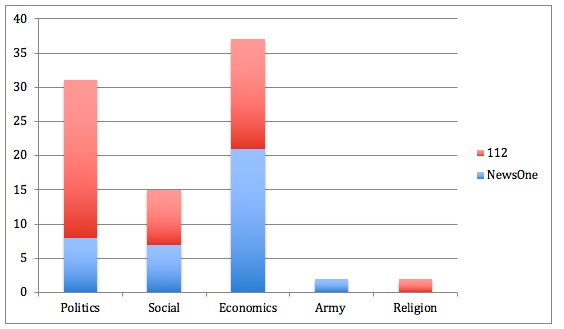
The Sources: Who Voiced Fake Messages
The content analysis allowed identifying the actors who were involved into promotion of fake messages. The Oppositional Parliament Representatives were the most active in claiming fake messages related to Ukraine on both channels. On the 112 Channel the mentioned actors have placed the most of the fake narratives (research identified 29 cases), followed by the invited Experts (10 cases). However, on the NewsOne the Oppositional Parliament Politicians have been often supported by the guests introduced as Experts; together they voiced almost the same number of fakes (9 and 11, accordingly).
Other politicians invited by the NewsOne channels have also contributed into dissemination of the fake narratives. In some cases, the narratives have also been claimed or supported by hosts of the talk shows or other journalists.
Interestingly, other types of sources, like for instance, public opinion surveys (applied only once by the NewsOne to support the argument of “Ukraine as a completely dependent on Russia”), Vox Populi, as well as the voices of representative’s of Ukrainian Army, Internally Displaced People, Ukrainian Church, representatives of International Organizations, EU or the USA did not appear among the sources related to fake narratives.
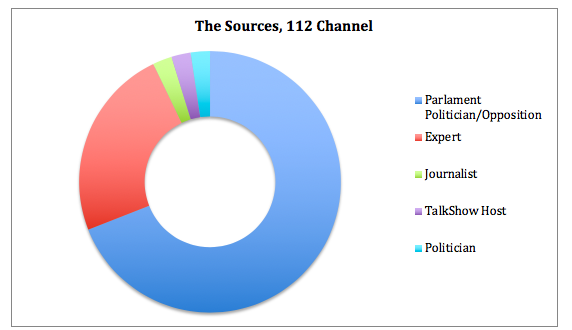
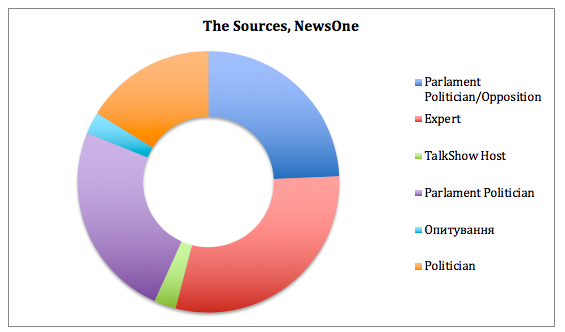
Conclusions
The idea of this research was to explore the narratives (with focus on fake narratives) as they are promoted by Ukranian oppositional TV channels during the Presidential campaign 2018-2019. Based on the thematic content analysis of two oppositional TV Channels (NewsOne and 112), it has indicated the fake narratives and explored the ways (themes, topics, arguments and sources) those narratives have been embedded into talk the shows` discussion. As a result the research the following conclusions could be made:
- Themes applied as a space for fake narratives. According to the research findings, oppositional media in Ukraine tend to provide space and promote fake narratives that are mostly centered on Ukraine`s domestic agenda problems and within the discussions on economical, political and in some cases social topics.
- The narrative of Ukraine as a “Failed State” (already identified by previous research (Fedchenko, 2016), has been dominating on both channels in December 2018. In times of Presidential Campaign Ukrainian media tended to develop this “Failed State” narrative around the “failed government” theme and linked to the “failed reforms” and “not effective government that led Ukraine to total collapse”.
- “Failed State” narrative has been closely linked and in some cases combined with two other “Poor and Starving Ukraine” and “Totally dependent on Russia” narratives. In many cases those narratives appealed to emotions and fake claims intending to depict Ukraine as a totally ruined and sinking into poverty country (again, as a result of the not effective government) claiming that to survive “Ukraine must negotiate with Russia”.
- Fakes related to Russia and Western Stakeholders. The research has also found that both TV Channels also contributed into ”Legitimation of Crimea Annexation” narrative and promotion of “Russia as “not a part of the occupation/war” narrative. Referring to the Western stakeholders, the oppositional TV channels tended to place narratives of “Decline of Western support for Ukraine” and “manipulated information on International Organizations”.
- Meanwhile, other themes, for instance, the ones related to Russia’s Invasion and War, Ukrainian Army, Religion/Tomos, Volunteer Battalions, Displaced people have not been identified as the themes of December programs or as ones around which fake narratives were placed.
- The invited Oppositional Parliament politicians and the show guests introduced the Experts have been the most active in voicing the mentioned narratives. In some cases, the narratives have also been repeated by other invited politicians and in few cases they were embedded within the comments of the talk show hosts or as a part of data presented as survey findings.
Limitations and Future Research.
This research intended to shed some light on how oppositional media in Ukraine deal with the challenges of information war, and, specifically, explore how they are impacted by Russian propaganda during the critical times of presidential elections. This study provided some valuable empirical evidences and allowed to trace some similar narratives in Ukrainian media that have already been found in previous research as the ones manufactured and disctributed by Kremlin.
However, due to exploratory nature of this research as well as limited time and other resources, it has been limited to only two media, one month timing and focused on the format of political talk show. Future investigations could also involve research of the news programs and aimed at exemination of fake narrative of the news coverage. Further research could also rely on both textual and visual data to investigate and compare the strategies of fake narratoves setting and promotion as they applied by different types (including social media) of media inside and outside of Ukraine.
[1] Esipova N. & Ray J. Information Wars. Ukraine and the West vs. Russia and the Rest. Harvard International Review. May 6, 2016. http://hir.harvard.edu/article/?a=13043
[2]Stop Fake. https://www.stopfake.org/en/how-to-identity-a-fake/
[3] Kramer A. To Battle Fake News, Ukrainian Show Features Nothing but Lies. New York Times. February 26, 2017. https://www.nytimes.com/2017/02/26/world/europe/ukraine-kiev-fake-news.html
[4] Stop Fake. https://www.stopfake.org/en/about-us/
[5] Fedchenko. Y. ‘Kremlin Propaganda: Soviet Active Measures by Other Means’. Estonian Journal of Military Studies, Volume 2, 2016, pp. 140–169
[6] Hindman M. & Barash V. (2018). Dessimination of Fake News and Influence Campaigm on Twitter. https://kf-site-production.s3.amazonaws.com/media_elements/files/000/000/238/original/KF-DisinformationReport-final2.pdf
[7] Guynn J. Russia`s Internet Research Agency may have been behind Facebook elections meddling. USA Today. November 7 2018. https://eu.usatoday.com/story/news/2018/11/06/russias-ira-may-behind-facebook-instagram-election-interference/1916737002/
[8] Ukraine’s Central Election Commission. Candidates for President http://www.cvk.gov.ua/pls/vp2019/wp003?PT001F01=719
[9] https://detector.media/infospace/article/143240/2018-12-10-nezalezhna-mediina-rada-znaishla-movu-vorozhnechi-i-vipravdannya-agresora-na-newsone/
[10]see the case of National Council of Information accusing 112 Channel in distribution of fake content. https://detector.media/infospace/article/139282/2018-07-12-natsrada-vigrala-apelyatsiyu-v-newsone-shchodo-poperedzhennya-za-feik/
[11] https://ms.detector.media/monitoring/talk_show/tarifniy_suitsid_oglyad_politichnikh_tokshou_39_grudnya_2018_roku/
[12] Freedom House. Report on Ukraine. https://freedomhouse.org/report/freedom-world/2019/ukraine
[13] “Freedom of Expression in post-Euromaidan Ukraine: External Aggression., Internal Challenges” Pen International Resport (principal researchers Sololelnko I., Grynko A.) https://pen-international.org/app/uploads/archive/2017/09/PEN-International-Ukraine-Report.pdf
[14] NewsOne. https://newsone.ua/about-channel/o-nas.html
[15] the 112. https://ua.112.ua/pro-nas
[16] https://video-ua.112.ua/politychne-tok-shou-puls-vypusk-vid-29012019-288575.html


